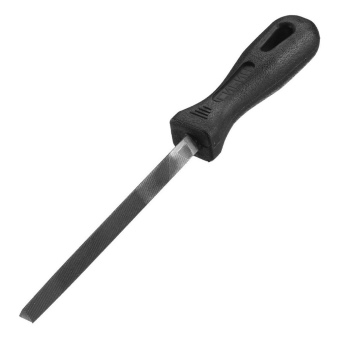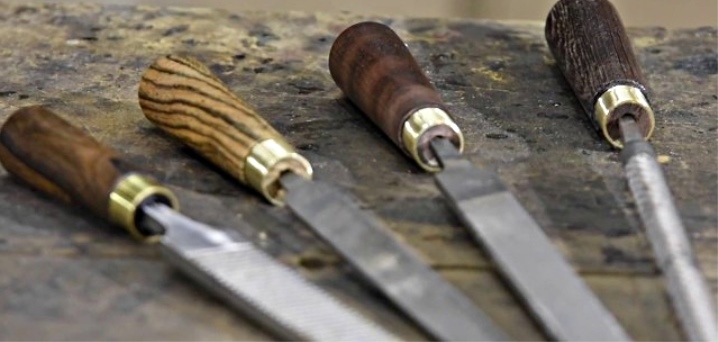What are the file handles?

The file handle is an important component that affects the usability of the tool and its functionality. Wooden and plastic models for the file are considered traditional, but there are also rubberized options, as well as made from other materials. It will be useful for every novice craftsman to learn how you can make and fit a handle for a file from a pipe, an old screwdriver with your own hands.

Manufacturing materials
The handle for a file or for a file must meet certain parameters. For it, strength and hardness, resistance to mechanical abrasion and stress are important. All these qualities are fully possessed by products made of several materials.
- Made of wood. This is the most commonly used hard rock material. The wooden handle is durable, it can be modified to fit the specified parameters. Usually birch is the main raw material, but maple, walnut, sea buckthorn, linden or ash can be used.
- Made of plastic. The plastic handle is vulnerable to operation at low and high atmospheric temperatures. It is molded with a ribbed surface that improves palm contact with the resin base. Plastic handles are typical for lightweight files.
- Made of composite materials. The most commonly used option is in which the plastic base is combined with a rubberized surface that improves the grip and reduces the sliding of the tool in the palm. It is ideal for small to medium sized files as well as large files with a flat working surface. Composite handle provides comfortable handling in all operating conditions.


When making the file handle yourself, more exotic materials are also used. For example, pieces of metal pipe, lead blocks, compressed waste paper.
Choosing non-standard solutions, it is worth considering their strength and functionality. Not all handicraft pens are comfortable and durable.
Types and sizes
There are several types of file handles. Most often they are made in the form of simple cylinders, with a rounded end on one side and a collet chuck on the other. For thin and light filed files of the sharpening type, more ergonomic pear-shaped handles are used, tapering to the working part of the tool. Flat options are used with sharp-nosed and blunt-nosed instruments of the same shape.


Standard dimensional parameters of the handle are selected individually, taking into account the width of the master's palm. It is important that the length of this element is at least 1/4 of the working blade. Otherwise, it will be simply inconvenient to hold the instrument. Typical lengths range from 80 to 160 mm, with 200 mm options in combination with a particularly large file.


By the method of insertion, they are isolated file handle options with collet or ring and one-piece, into which the base of the tool is fused during production. The second option is typical for plastic and composite products.

In addition, universal quick-release options are available with a tapered shank type. They easily adapt to the size you want.
How to do it yourself?
Homemade file pens often do not require the creation of even a primitive drawing.The work takes a minimum of time; you can use any materials at hand as a basis. For example, there are homemade handles that craftsmen were able to make from a pipe or plastic bottle. Some options that deserve special attention are worth considering in more detail.


From an old screwdriver
Such options can most often be found in sets, where miniature inserts with different widths and types of sting are placed in a larger handle. Over time, the edges of the base are erased, the contact ability of the accessory deteriorates, but it may well serve when attaching other tools.


To adapt to a new base, you just need to fill the handle cavity with hot hot melt glue, while heating the file shank with a construction hair dryer.
After that, it remains to combine the parts, wait for the hot melt to grab. If necessary, it can be added directly while the file is being inserted.

From a plastic bottle and a mop handle
To make a simple file handle from scrap materials, you need to take a piece of cutting 80-160 mm long, plastic bottles with a narrow neck, carpentry or universal glue. The order of work includes several points.
- Making a ring. The neck of the bottle is fixed with a vice, sawed off with a hacksaw at the top. The resulting element will act as a crimp ring.
- Cutting preparation. It is cut to a predetermined length, tried on to the ferrule. Part of the wood is removed from the surface - for a tighter fit of the plastic part, then it is sharpened with emery so as to acquire a slightly conical shape.
- Fitting the ferrule to the handle. It is made with glue. It is important that the ring fits tightly enough even without additional clips.
- Installing the handle on the file. A hole is drilled in the end face of the auxiliary element for the diameter of the tool shank. A little glue can be poured inside in front of the nozzle. After that, the handle will sit easily on the file.

This is a simple solution for most file types, from miniature files to large size models.

Out of the pipe
When there is no block of wood or other more familiar materials at hand, you can even use a piece of plastic pipe. It is best to use polypropylene options. The segment is fixed horizontally in the bed. On the one hand, insert a shank into the hole, on the other - molten plastic or hot melt glue is poured.

Once the composition has set, a hole can be drilled in the handle for hanging storage.
How to plant correctly?
Putting the file on the handle correctly is a difficult task for a beginner. It is important to make sure that every stage of this process goes through all the rules.
- Hole preparation. It is burned out or drilled into the base of the handle. To prevent cracking of the material, a metal ring is preliminarily put on it. The depth of the hole must match the length of the shank.
- Pre-installation. At this stage, the elements are fitted to each other. The shank is placed in the prepared hole.
- Nozzle. You need to take the file by its working part with your right hand, and then lightly hit the outer end of the handle on the workbench. And you can also rest the tool with the working edge on a hard surface. After that, the hammer strikes the handle, completing the insertion process.

It is important to remember that file accessories and accessories are rarely reusable. Experienced craftsmen prefer to make their own handle for each tool, since when changing the base it turns out to be impossible to ensure a sufficiently tight fit.

You can learn more about the process in the following video.













The comment was sent successfully.